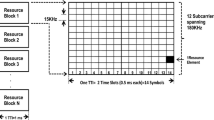Abstract
Improved resource allocation scheme for optimizing the performance of cell edge users in Long Term Evolution-Advanced (LTE-A) system is proposed in this paper. The proposed algorithm optimally assigns and allocates Carrier Components (CCs), Radio Blocks (RBs) and Modulation and Coding Scheme (MCS) index for the users based on the Quality of Service (QoS) provision to meet the on demand service requests. The proposed algorithm divides the cell regions into cell centre and cell edge depending on the traffic load on the network. The available RBs are allocated to meet the on demands requests of the users among these two regions. RB usage ratio for optimizing the performance of the scheduling algorithm is used during resource allocation. As the RB usage ratio reaches more than 70%, throughput and data rates of the cell may not be reached in timely and reliable manner. The proposed algorithm takes RB usage ratio into consideration during scheduling to maintain minimum QoS provisions of the users for resource allocation. Simulation result shows that, performance of the cell edge users optimally met with minimum throughput and data rates for reliable communication in the LTE-A system.







Similar content being viewed by others
References
Abbas MT, Muhammad A, Song W, SD-IoV. (2020) SDN enabled routing for internet of vehicles in road-aware approach. J Ambient Intell Human Comput 11:1265–1280. https://doi.org/10.1007/s12652-019-01319-w
Ameigeiras P, Navarro-Ortiz J, Andres-Maldonado P et al (2016) 3GPP QoS-based scheduling framework for LTE. J Wirel Com Netw 2016:78. https://doi.org/10.1186/s13638-016-0565-9
Bilisik HE, Sokullu R (2018) A novel fair and efficient resource allocation scheduling algorithm for uplink in LTE-A. Adv Sci Technol Eng Syst J 3(6):222–232
Bojović B, Meshkova E, Baldo N et al (2016) Machine learning-based dynamic frequency and bandwidth allocation in self-organized LTE dense small cell deployments”. EURASIP J Wirel Commun Netw. https://doi.org/10.1186/s13638-016-0679-0
Gadam MA, Ahmed MA, Ng CK, Nordin NK, Sali A, Hashim F (2016) Review of adaptive cell selection techniques in LTE-advanced heterogeneous networks. J Comput Netw Commun 2016:1–12
Gadam MA, Nordin NK, Maijamaa L (2018) Combined channel gain and QoS-based access-aware cell selection in LTE-Advanced HetNets. In: 2018 IEEE 5G world forum (5GWF), Silicon Valley, CA, pp 532–535. https://doi.org/10.1109/5GWF.2018.8516714
Gatti R, Shankar S (2017) Study of different resource allocation scheduling policy in advanced LTE with carrier aggregation. In: IEEE International Conference on Recent Trends in Electronics, Information & Communication Technology (RTEIC), Bangalore. https://doi.org/10.1109/RTEICT.2017.8257002
Gatti R, Shankar S (2019) Extension of modified joint uplink and downlink scheduling algorithm for LTE-A in femtocell networks. Int J Sens Wirel Commun Control. https://doi.org/10.2174/2210327909666191126112740
Hwang S, Park S (2017) On the effects of resource usage ratio on data rate in LTE systems. In: 19th International Conference on Advanced Communication Technology (ICACT), Bongpyeong. https://doi.org/10.23919/ICACT.2017.7890060
Khan MHA, Chung J, Lee MH (2016) Downlink performance of cell edge using cooperative BS for multicell cellular network. J Wirel Com Netw. https://doi.org/10.1186/s13638-016-0537-0
Kim J, Park DG, Jeong J (2019) Design and performance evaluation of cost-effective function-distributed mobility management scheme for software-defined smart factory networking. J Ambient Intell Human Comput. https://doi.org/10.1007/s12652-019-01356-5
Liu L, Garcia V, Tian L, Pan Z, Shi J (2015) Joint clustering and inter-cell resource allocation for CoMP in ultra dense cellular networks. In: Proceedings of the IEEE international conference on communications (ICC), pp 2560–2564
Määttänen H, Hämäläinen K, Venäläinen J et al (2012) System-level performance of LTE-advanced with joint transmission and dynamic point selection schemes. EURASIP J Adv Signal Process. https://doi.org/10.1186/1687-6180-2012-247
Mousavi H, Iraj S, Amiri MA, Mostafavi, Choon CY (2017) LTE physical layer: performance analysis and evaluation. Appl Comput Inform. https://doi.org/10.1016/j.aci.2017.09.008
Peng M, Wang C, Lau V, Poor HV (2015) Fronthaul-constrained cloud radio access networks: insights and challenges. IEEE Wirel Commun 22(2):152–160
Reddy GT, Sudheer K, Rajesh K, Lakshmanna K (2014) Employing data mining on highly secured private clouds for implementing a security-asa-service framework. J Theor Appl Inf Technol 59(2):317–326
Rostami S, Arshad K, Rapajic P (2015) A joint resource allocation and link adaptation algorithm with carrier aggregation for 5G LTE-Advanced network. In: International conference on telecommunications (ICT), Sydney, NSW. https://doi.org/10.1109/ICT.2015.7124665
Song JS, Jin H, Kwon H, Park S (2019) Measurement-based performance investigation on mobile video streaming in LTE-A cell edge areas. In: 25th Asia-Pacific conference on communications (APCC), pp 215–220
Tian H, Gao S, Zhu J, Chen L (2011) Improved component carrier selection method for non-continuous carrier aggregation in LTE-Advanced systems. In: IEEE vehicular technology conference (VTC Fall), San Francisco https://doi.org/10.1109/VETECF.2011.6092963
Wang L, Fang F, Nikaein N, Cottatellucci L (2016) An analytical framework for multilayer partial frequency reuse scheme design in mobile communication systems. IEEE Trans Veh Technol 65(9):7593–7605
Yu J, Wang Y, Gu S, Zhang Q, Chen S, Zhang Y (2019) Cross-entropy method for content placement and user association in cache-enabled coordinated ultra-dense networks. Entropy 21:576. https://doi.org/10.3390/e21060576
Zhang H, Wang X, Liu Y et al (2012) Resource allocation for relay-assisted OFDMA systems using inter-cell interference coordination. J Wirel Com Netw. https://doi.org/10.1186/1687-1499-2012-156
Zhang X, Peng M, Wang Z, Mai S (2018) Performance analysis and evaluation of cloud radio access networks. In: International conference on computing, networking and communications (ICNC), pp 68–72
Zheng C, Hailin Z (2019) A quasi-perfect resource allocation scheme for optimizing the performance of cell-edge users in FFR-aided LTE-A multicell networks. IEEE Commun Lett 23(5):918–921
Funding
Nil.
Author information
Authors and Affiliations
Corresponding author
Ethics declarations
Conflict of interest
The authors declare no conflict of interest, financial or otherwise.
Availability of data and material
All data and material used for preparation included in manuscript itself.
Additional information
Publisher's Note
Springer Nature remains neutral with regard to jurisdictional claims in published maps and institutional affiliations.
Rights and permissions
About this article
Cite this article
Gatti, R., Shivashankar Improved resource allocation scheme for optimizing the performance of cell-edge users in LTE-A system. J Ambient Intell Human Comput 12, 811–819 (2021). https://doi.org/10.1007/s12652-020-02084-x
Received:
Accepted:
Published:
Issue Date:
DOI: https://doi.org/10.1007/s12652-020-02084-x




